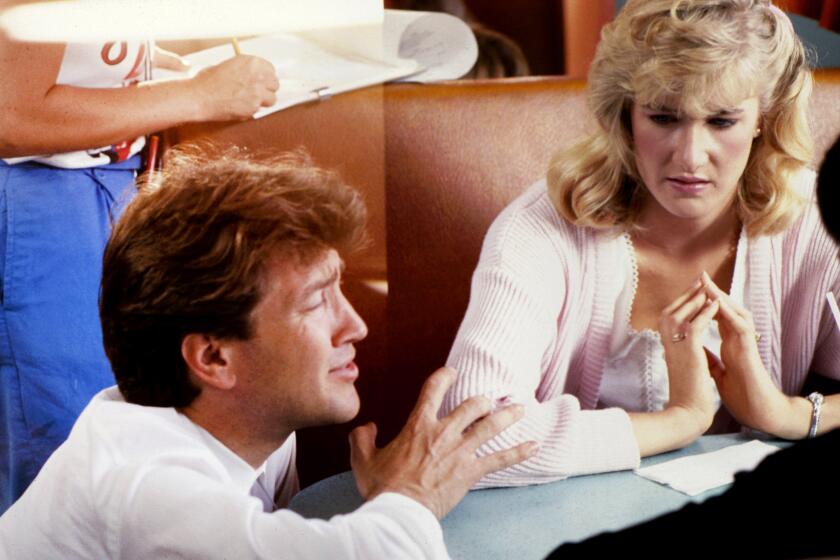Gentle ‘Weeping Camel’ charms with simple tale
- Share via
Camels are always ready for their close-ups. Regal creatures of enormous dignity and unexpected elegance, they have considerable screen presence, the animal equivalent of star power to burn.
Though humans play a prominent role in “The Story of the Weeping Camel,” these eminently watchable creatures are, not surprising given the title, this unusual film’s protagonists. “Weeping” is a simple tale of animal estrangement and reconciliation that in its own quiet way manages to be soothing, hypnotic, even magical.
Set in the proverbially vast spaces of Mongolia’s Gobi desert, “Camel” was co-written and co-directed by two colleagues who met at film school in Munich, Germany: Byambasuren Davaa, a Mongolian with documentary experience, and the Italian-born Luigi Falorni.
Their idea was to do what they call a “narrative documentary,” combining genuine reality sequences with carefully crafted re-creations of authentic situations. It’s a way of working inspired by the modus operandi of the classic documentarian Robert Flaherty, whose 1922 “Nanook of the North” was a sensation in its day.
First, the filmmakers chose a family of nomadic herders, four generations living together under the same expansive yurt roof, and had them play, yes, a family of nomadic herders, taking on, in Falorni’s phrase, “the same roles they have in real life.”
This, the human part of “Weeping Camel,” is a charming slice of everyday Mongolian life. We see, sometimes in re-created scenes, members of this extended family gathering firewood, making soup, playing cards, eating ice cream. The two smallest children, Ugna and Dude, are even overheard, in classic kid fashion, chiding their grandmother for repeating a story she’s told them once before.
Because there is no voice-over, and because Davaa is herself the grandchild of nomads, “Weeping Camel” does a convincing job of dropping us into its characters’ reality, empathetically allowing the simplicity of these people to envelope and sustain us.
The filmmakers wanted their central dramatic event to be real, not re-created, so they were at the mercy of whatever happened to this nomadic family and their herd of camels, sheep and goats. In a burst of good fortune, the series of events that was at the top of their wish list actually took place before their eyes.
One of the family’s two-humped Bactrian camels first gives birth to a rare white colt and then, as apparently not infrequently happens, refuses to let the baby nurse. Rejected by its mother, the young colt languishes on the plain, getting progressively weaker and coming out with the most agonizing crying noises, the high lonesome sound of abandonment that is woeful to hear.
Because the family livelihood depends on healthy animals, the elders turn to the traditional ritual (there really is one) for changing a camel mother’s mind. A singer and musician is brought in from another town, and he proceeds to produce a haunting melody that is supposed to move the mother so much that she will allow the colt to nurse and cry real tears in the process, hence the film’s name.
Beautifully photographed and willing to trust the unadorned power of straightforward events for its emotional effects, “The Story of the Weeping Camel” has confidence to go along with its gentleness. Though often on the move, its characters, both human and Bactrian, know enough not to hurry when rushing would serve no purpose.
*
‘The Story of the Weeping Camel’
MPAA rating: PG for some mild thematic content.
Times guidelines: scenes of camels being born.
Uuganbaatar Ikhbayar...Ugna
Odgerel Ayusch...Odgoo
Janchiv Ayurzana...Janchiv
Enkhbulgan Ikhbayar...Dude
Released by Thinkfilm in association with National Geographic World Films.
Directors Luigi Falorni and Byambasuren Davaa. Producers Evi Stangassinger, Natalie Lambsdorff. Screenplay Luigi Falorni and Byambasuren Davaa.
Cinematographer Luigi Falorni. Editor Anja Pohl. Running time: 1 hour, 30 minutes.
In limited release.
More to Read
Only good movies
Get the Indie Focus newsletter, Mark Olsen's weekly guide to the world of cinema.
You may occasionally receive promotional content from the Los Angeles Times.











